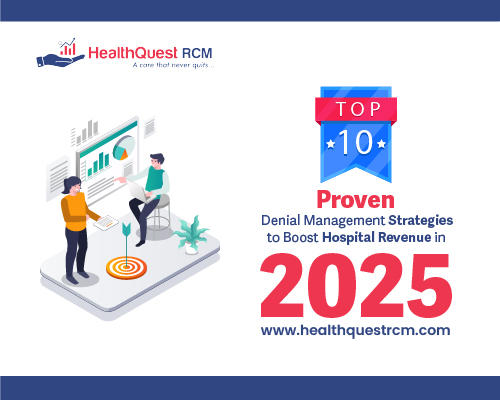As healthcare costs continue to rise and margins tighten, managing the revenue cycle has never been more important. For hospitals and health systems, tackling claim denials is a critical part of the equation. In 2025, organizations must move beyond reactive billing processes and adopt proactive denial management strategies to stay financially healthy.
Denied claims slow down payments, increase administrative burden, and create a negative experience for both providers and patients. But with the right approach, it’s possible to significantly reduce insurance denials in healthcare and ensure a smoother, more profitable revenue cycle.
Here are 10 ways to improve denial management, prevent claim rejections, and ultimately boost hospital revenue in 2025.
1. Verify Patient Eligibility Upfront
Eligibility issues remain a top reason for denials. Implementing real-time insurance verification tools at the point of scheduling or registration can ensure accurate coverage data before services are rendered.
2. Improve Documentation Accuracy
Incomplete or inconsistent clinical documentation can lead to coding errors and rejected claims. Investing in clinical documentation improvement (CDI) programs helps ensure that diagnoses and treatments are clearly captured and coded correctly.
3. Automate Claims Management
Manual processes leave room for error and slow down reimbursement. By using automated tools for claim scrubbing, coding, and submission, providers can prevent many avoidable denials before they reach payers.
4. Standardize Denial Codes and Processes
Every department should be on the same page when it comes to identifying, categorizing, and addressing denials. A standardized approach helps identify patterns and streamline appeal workflows.
5. Train Front-End Staff on Payer Policies
Your front-line staff plays a crucial role in reducing denials. Regular training on payer-specific guidelines, prior authorization requirements, and documentation standards can help catch issues before they become denials.
6. Implement Real-Time Claim Edits
Real-time edits during claim creation can catch missing or incorrect data immediately. This ensures higher clean-claim rates and faster payments.
7. Track and Analyze Denial Trends
Monitoring key denial metrics like denial rate by payer or denial reason codes helps identify root causes. This data-driven approach allows for more strategic denial management strategies tailored to your organization.
8. Strengthen Communication Between Departments
Break down silos between clinical, billing, and administrative teams. Stronger communication ensures that billing issues are caught early and that documentation aligns with coding and payer expectations.
9. Appeal Denials Promptly and Effectively
A structured, timely appeals process improves your chances of overturning denials. Use templates, pre-built responses, and a centralized denial tracking system to improve response times and accuracy.
10. Leverage AI and Predictive Analytics
Modern revenue cycle platforms use AI to flag high-risk claims and predict denial likelihood. These tools help teams focus on what matters most, preventing claim rejections and recovering lost revenue.
Conclusion
In 2025, hospitals must approach denial prevention as a core part of their revenue strategy—not just a back-office task. By adopting smarter workflows, leveraging technology, and fostering interdepartmental alignment, healthcare organizations can significantly reduce insurance denials, enhance operational efficiency, and boost hospital revenue.
These 10 denial management strategies are not just about fixing what’s broken,they’re about building a proactive, resilient revenue cycle that supports better financial health and better patient care.
Ready to Strengthen Your Revenue Cycle in 2025?
At HealthQuest, we help healthcare organizations implement smarter, scalable denial management strategies that reduce claim rejections and increase collections.
Let’s optimize your revenue cycle together, starting now.
Get in Touch with HealthQuest.
Frequently Asked Questions (FAQ)
The most frequent causes include eligibility issues, missing or incorrect information, lack of prior authorization, and coding errors.
Ideally within 7 days. Prompt responses increase the likelihood of successful appeals and faster reimbursements.
Yes. Automated claims scrubbing, eligibility checks, and real-time edits catch errors before submission, greatly reducing preventable denials.
Fewer denials mean faster reimbursements, lower administrative costs, and more predictable cash flow, all of which contribute to stronger financial performance.
Start by analyzing your denial data to identify trends and root causes. From there, build targeted strategies focused on people, processes, and technology.

